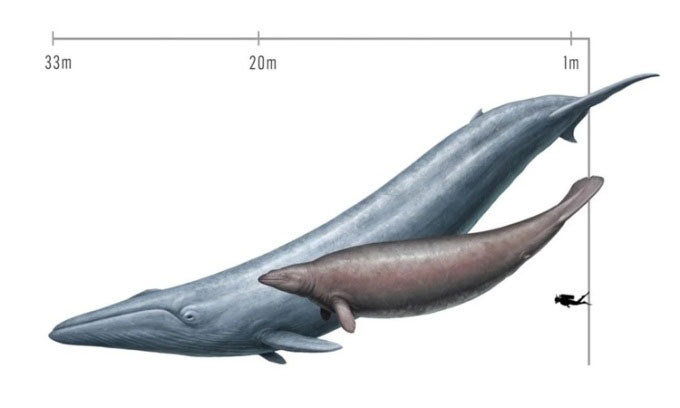The blue whale reclaims the title of largest animal on the planet
New research results show that the ancient whale Perucetus was very large but still smaller than today's blue whales .
Last August, a group of paleontologists announced the discovery of fossil bones of a giant ancient whale. According to them, the Perucetus whale could weigh more than 200 tons, making it the heaviest animal to ever live on Earth. But in research published in the journal PeerJ, two scientists refuted that speculation. According to Nicholas Pyenson, a paleontologist at the Smithsonian Museum of Natural History, one of the two authors of the new study, the above number is meaningless, Interesting Engineering reported on March 1.

Compare the sizes of the blue whale, the extinct Perucetus whale, and humans. (Photo: Cullen Townsend)
Analysis by Pyenson and Ryosuke Motani, a paleontologist at the University of California, Davis, concluded that Perucetus could have weighed 60-70 tons, about the size of a sperm whale. They also analyzed blue whale fossils and provided new estimates of the species' weight. They concluded that the blue whale weighed up to 270 tons, much larger than previous estimates of 150 tons . Therefore, they are the heaviest known species in the history of the animal kingdom.
Perucetus first attracted attention in 2010 when Mario Urbina, a paleontologist at the Museum of Natural History at the National University of San Marcos in Lima, Peru, came across a bone in the southern desert Peru. He and his colleagues excavated 13 vertebrae, 4 ribs and part of the pelvis. The bones have many characteristic signs of whale bones but are unusually large and heavy. Urbina's team reconstructed the entire skeleton of Perucetus by studying much smaller whales that lived at the same time. They also took inspiration from manatees alive today, whose compact skeletons allow them to submerge underwater to graze on sea grass.
Urbina and his colleagues produced a reconstructed image of a strange animal. It has a giant long trunk, a small head, and flippers and hind legs. Motani, an expert in reconstructing the bodies of extinct marine animals, was quite confused by that conclusion. He contacted Pyenson, an expert on whale fossils. Both felt that modeling Perucetus after manatees was a mistake, since only whales had evolved to their maximum size.
In the new study, Pyenson and Motani looked at living whale species. Because it is impossible to put a live blue whale on the scale, no one has accurately measured its weight. The team reviewed data collected by Japanese whaling ships in the 1940s, and used that information as the basis for the new estimate. They also created a 3D model of a blue whale, which was used as a model of Perucetus. With this approach, they estimated Perucetus weighed 60 - 70 tons, much less than previous conclusions.
Eli Amson, a bone tissue expert at the Natural History Museum in Stuttgart, Germany, and co-author of the previous study, disagreed with Pyenson and Motani's approach. According to him, the extinct blue whale has very different biological characteristics from recent whale species. He and his colleagues are creating their own 3D models of ancient animals. They found that Perucetus was much more similar to a manatee than initially thought, reinforcing the conclusion that it was as large or larger than a blue whale in weight.
Pyenson said Perucetus is still a major find, despite its small size according to his and Motani's conclusions. Paleontologists have long believed that whales evolved to giant sizes in just the past few million years. Even at 60 tons, Perucetus was a giant among early whales.
- Close up of the largest 170 ton blue whale on the planet
- Extremely rare scene: The planet's largest creature ... 'walks badly' in the middle of the ocean
- Disaster turns blue whale into the largest creature on the planet
- Blue whale re-establish historical migration patterns
- Can you live in whale belly?
- The first measurement of the heart rate of the blue whale
- Top 6 largest fish in the ocean
- The blue whale's tongue is even heavier than an elephant
- What is the most 'long' animal on the planet?
- Heartbreaking image of the death of blue whale
- Close up of the biggest animal in the world
- Video: Blue whale wearing the whole boat jutting out of the water
 Surprised: Fish that live in the dark ocean still see colors
Surprised: Fish that live in the dark ocean still see colors Japan suddenly caught the creature that caused the earthquake in the legend
Japan suddenly caught the creature that caused the earthquake in the legend A series of gray whale carcasses washed ashore on California's coast
A series of gray whale carcasses washed ashore on California's coast Compare the size of shark species in the world
Compare the size of shark species in the world